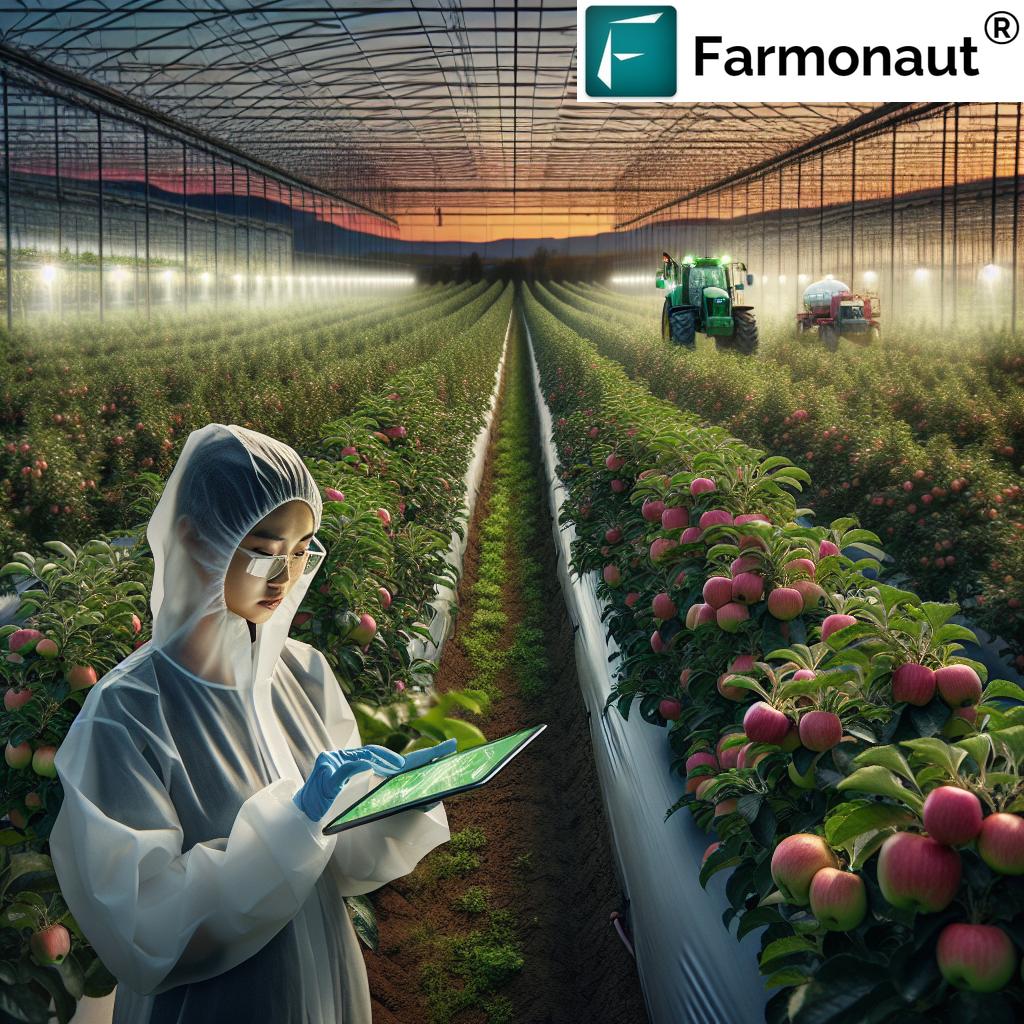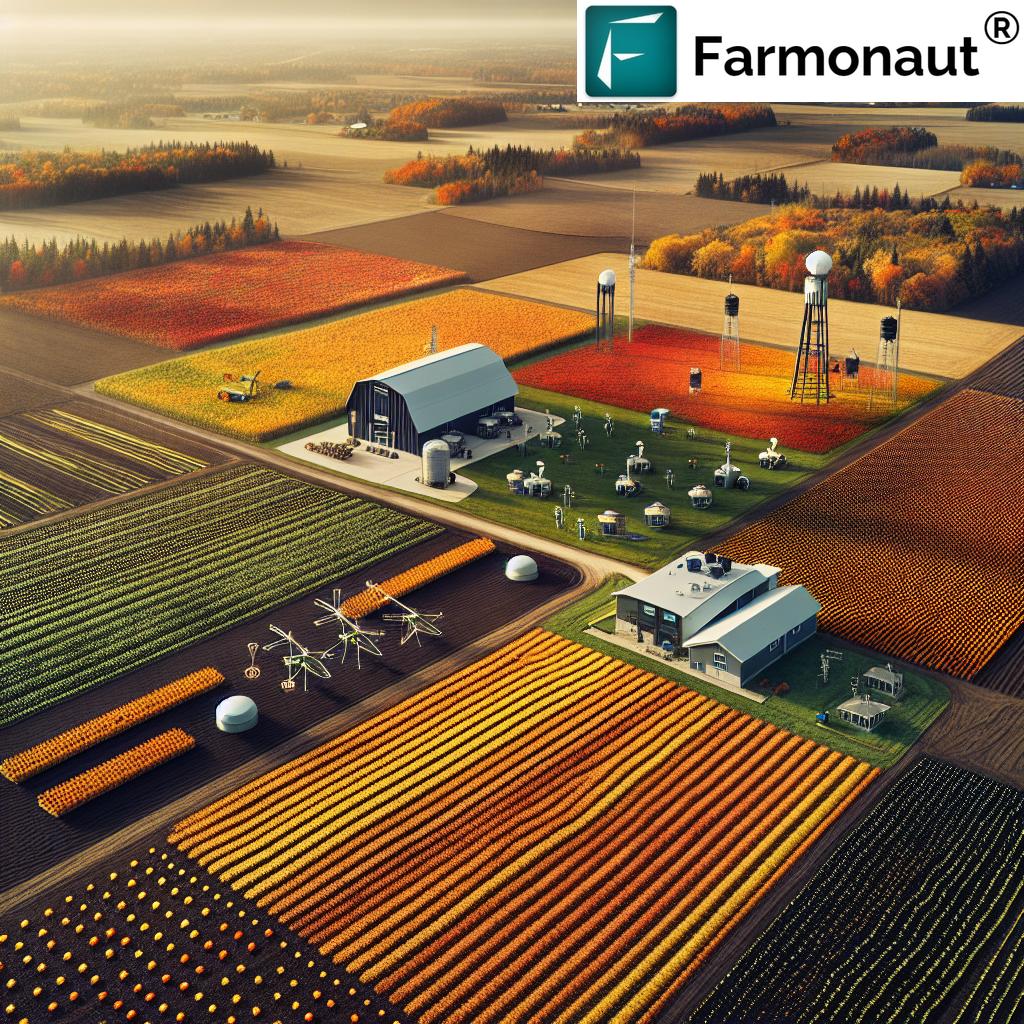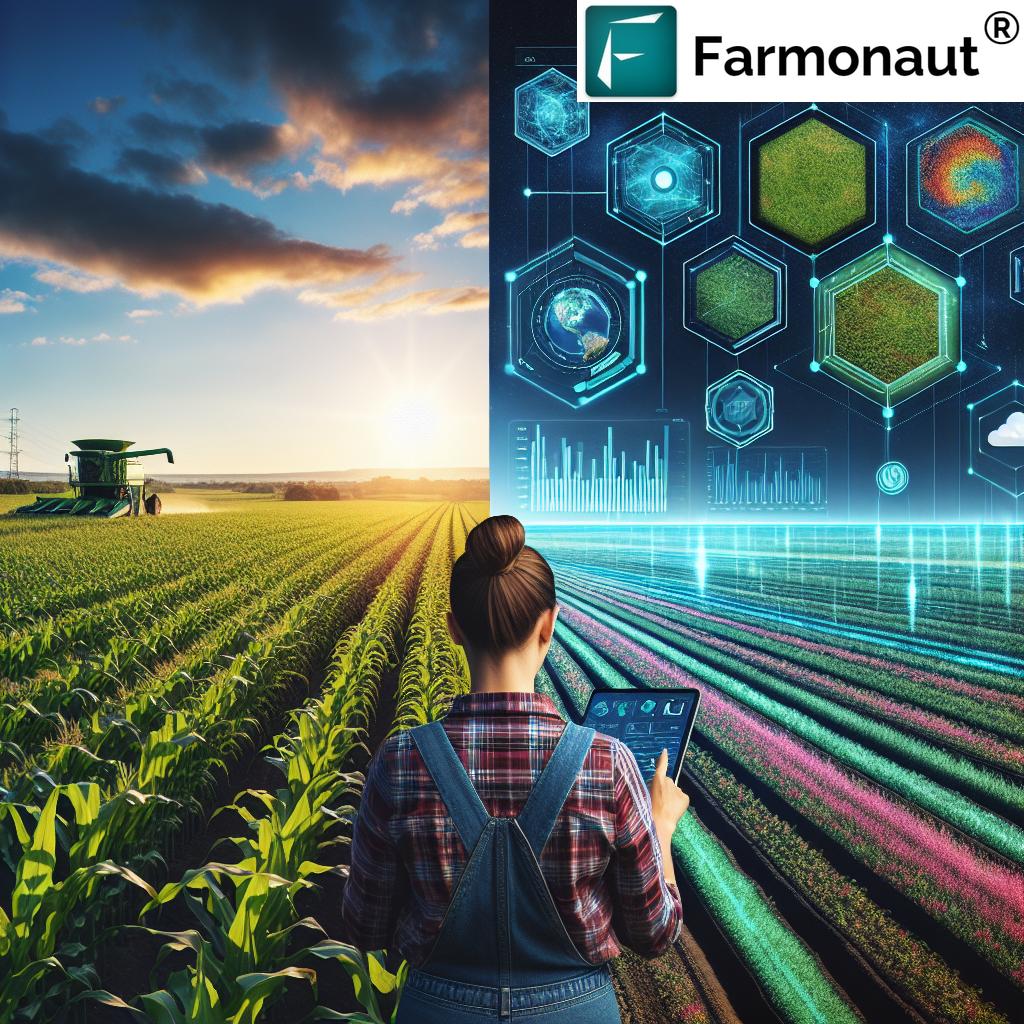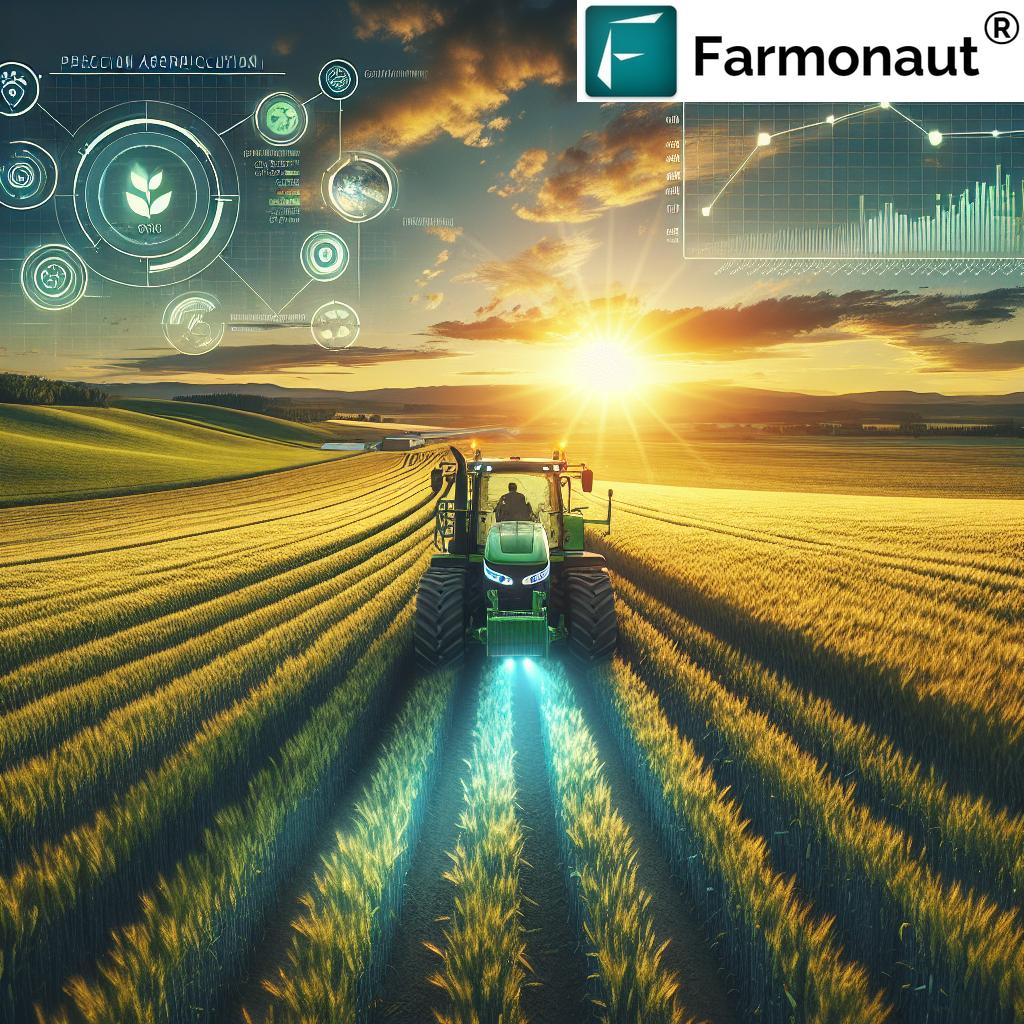Sustainable Farming Guide: From Summer Harvest to Winter Prep in Ontario – Farmonaut’s Essential Tips

“Ontario farmers can protect up to 90% of their crops from frost damage using proper winterization techniques.”
Welcome to our comprehensive guide on sustainable farming practices and small farm management in Ontario! As we transition from the bountiful summer harvest to winter preparation, we at Farmonaut are excited to share our essential tips for farmers and gardeners alike. In this blog post, we’ll explore a wide range of topics, from winterizing beehives to implementing potato storage techniques, and discuss how to adapt to the challenges posed by climate change in agriculture.
Let’s dive into the world of seasonal crop care and discover how you can make the most of your farm or garden throughout the year!
The Importance of Sustainable Farming Practices
Sustainable farming practices are at the heart of modern agriculture, especially for small farm management. These practices not only help preserve our environment but also ensure the long-term viability of our farms. Here are some key aspects of sustainable farming that we’ll be focusing on:
- Soil health improvement through composting and regenerative techniques
- Water conservation methods
- Integrated Pest Management (IPM) strategies
- Crop rotation and diversification
- Energy-efficient farming equipment and renewable energy solutions
By implementing these practices, we can create a more resilient and productive agricultural system that benefits both farmers and the environment.
Transitioning from Summer Harvest to Fall Preparations
As the warm summer days give way to crisp autumn air, it’s time to shift our focus from harvesting to preparing our farms and gardens for the colder months ahead. Here’s what you need to know:
Summer Harvest Wrap-up
Before we dive into fall preparations, let’s make sure we’ve made the most of our summer harvest:
- Complete harvesting of warm-season crops like tomatoes, zucchini, and peppers
- Process and preserve excess produce through canning, freezing, or dehydrating
- Collect and save seeds from open-pollinated varieties for next year’s planting
- Clear out spent plants and add them to your compost pile
Fall Planting and Soil Preparation
Fall is an excellent time to plant cool-season crops and prepare your soil for the next growing season:
- Plant fall crops such as lettuce, spinach, kale, and root vegetables
- Sow cover crops like rye or clover to protect and enrich the soil
- Conduct soil tests and amend accordingly with organic matter and minerals
- Implement composting techniques to improve soil health
Farmonaut Tip: Use our satellite-based crop health monitoring to track the progress of your fall plantings and optimize your soil management strategies. 
Winterizing Your Farm: Essential Steps
As winter approaches, it’s crucial to protect your farm assets and ensure they’re ready for the harsh weather ahead. Here are some key areas to focus on:
Winterizing Beehives
For beekeepers, proper winterization of hives is essential for colony survival:
- Ensure adequate food stores within the hive
- Reduce hive entrances to prevent drafts and pest entry
- Add insulation around the hives, leaving ventilation at the top
- Consider using windbreaks to protect hives from harsh winds
Potato Storage Techniques
Proper storage of potatoes is crucial for maintaining quality through the winter months:
- Cure potatoes at 50-60°F (10-15°C) with high humidity for 1-2 weeks
- Store in a dark, cool (38-40°F or 3-4°C) location with good ventilation
- Check regularly for any signs of spoilage and remove affected tubers
- Consider using natural materials like straw for insulation in storage areas
Protecting Gardens from Frost
To extend your growing season and protect sensitive plants from early frosts:
- Use row covers, cold frames, or hoop houses to create microclimates
- Apply a thick layer of mulch around plants to insulate the soil
- Water plants thoroughly before an expected frost to help retain heat
- Bring potted plants indoors or to a protected area
“Implementing regenerative agriculture practices can increase soil organic matter by 1% annually, boosting water retention by 20,000 gallons per acre.”
Soil Health Improvement Through Composting
Composting is a cornerstone of sustainable farming practices and plays a crucial role in improving soil health. Here’s how you can make the most of this natural process:
- Collect a mix of “green” (nitrogen-rich) and “brown” (carbon-rich) materials
- Layer materials in your compost bin or pile, ensuring proper aeration
- Maintain moisture levels similar to a wrung-out sponge
- Turn the pile regularly to speed up decomposition
- Apply finished compost to your fields or gardens to boost soil fertility
By incorporating composting into your farm management strategy, you’ll reduce waste, improve soil structure, and enhance nutrient availability for your crops.
Adapting to Climate Change in Agriculture
Climate change poses significant challenges to agriculture, but with the right strategies, farmers can adapt and thrive. Here are some key approaches:
- Diversify crops to spread risk and improve resilience
- Implement water-saving irrigation techniques like drip irrigation
- Use climate-resilient crop varieties adapted to changing conditions
- Adopt conservation tillage practices to reduce soil erosion
- Integrate agroforestry systems to improve farm biodiversity
Farmonaut’s Role: Our satellite-based crop monitoring and AI-powered advisory system can help you track changes in your farm’s microclimate and adapt your farming practices accordingly. Check out our API for more advanced features.
Innovative Regenerative Agriculture Technology
Regenerative agriculture goes beyond sustainability, aiming to actively improve the environment. Here are some innovative technologies supporting this approach:
- Precision farming tools for targeted resource application
- No-till seed drills that minimize soil disturbance
- Cover crop rollers for terminating cover crops without herbicides
- Biochar production systems for long-term carbon sequestration
- Holistic grazing management software for optimal pasture utilization
Farmonaut’s Contribution: Our platform integrates with various regenerative agriculture technologies, providing farmers with comprehensive data to make informed decisions. Learn more about our capabilities in our API Developer Docs.
Cybersecurity Tips for Modern Farms
As farms become increasingly digital, cybersecurity is more important than ever. Here are some essential tips to protect your farm’s data and operations:
- Use strong, unique passwords for all farm management software
- Keep all devices and software up to date with the latest security patches
- Implement two-factor authentication where possible
- Regularly back up important data to secure, offline storage
- Train all farm employees on basic cybersecurity practices
Farmonaut’s Security: We prioritize the security of your farm data. Our platform uses state-of-the-art encryption and follows best practices in data protection.
Local Farming and Fresh Produce for Thanksgiving
As Thanksgiving approaches, local farming plays a crucial role in providing fresh, seasonal produce for festive meals. Here’s how you can make the most of your harvest:
- Plan your crop timing to ensure a bountiful harvest for Thanksgiving
- Focus on traditional Thanksgiving vegetables like squash, pumpkins, and sweet potatoes
- Consider value-added products like homemade preserves or baked goods
- Participate in local farmers’ markets or community-supported agriculture (CSA) programs
- Collaborate with local restaurants or caterers for farm-to-table Thanksgiving menus
Delicious Recipes Featuring Homegrown Vegetables
Make the most of your harvest with these mouthwatering recipes:
- Zucchini Fritters: Grate zucchini, mix with flour, eggs, and herbs, then fry until golden.
- Roasted Heirloom Tomato Soup: Slow-roast tomatoes with garlic and herbs, then blend for a rich soup.
- Stuffed Acorn Squash: Fill halved squash with a mixture of quinoa, cranberries, and pecans.
- Maple-Glazed Carrots: Roast carrots with a glaze of local maple syrup and fresh thyme.
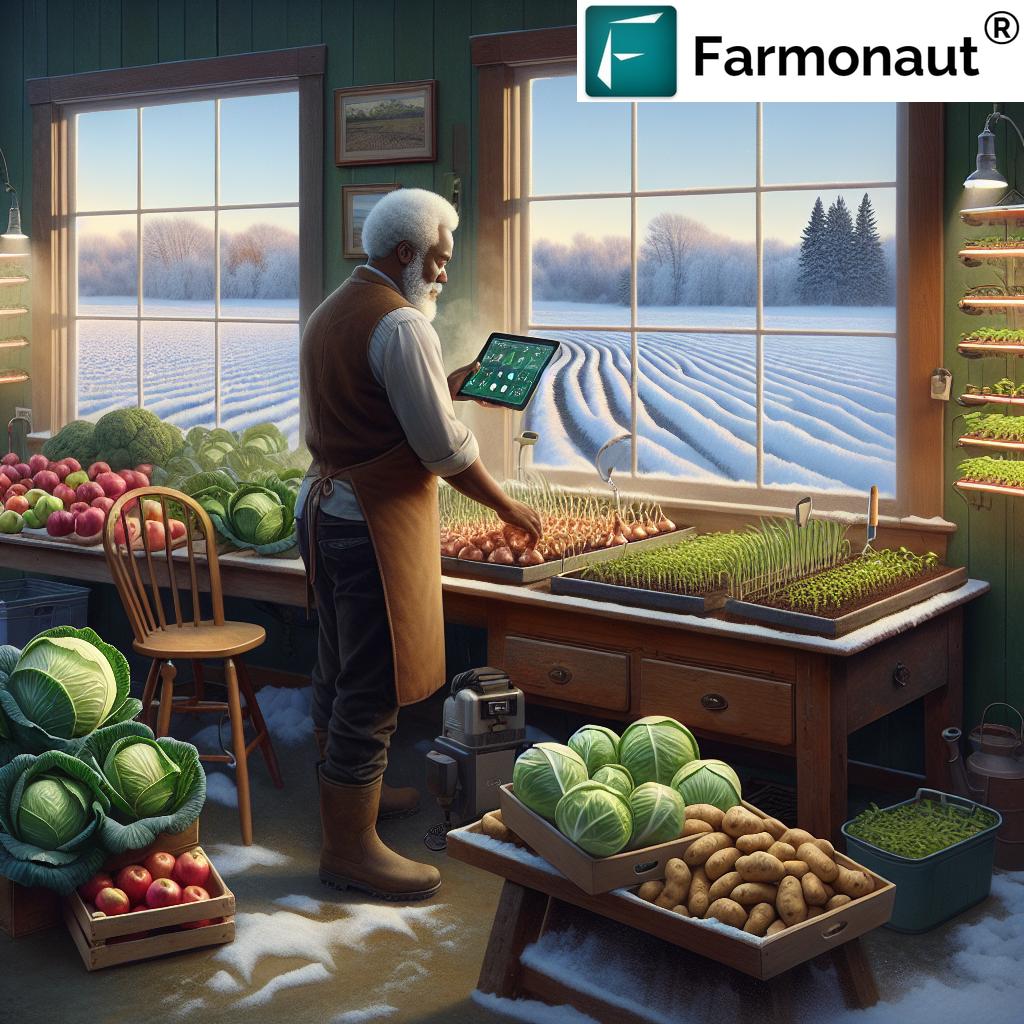
Farm Equipment and Renewable Energy Solutions
Investing in the right equipment and embracing renewable energy can significantly improve your farm’s efficiency and sustainability. Here are some considerations:
Essential Farm Equipment for Small-Scale Operations
- Compact tractors with versatile attachments
- Walk-behind tillers for smaller plots
- Irrigation systems with smart controllers
- Small-scale harvesting equipment
- Post-harvest processing tools (e.g., washers, sorters)
Renewable Energy Options for Farms
- Solar panels for powering farm buildings and equipment
- Wind turbines for areas with consistent wind
- Biomass boilers using agricultural waste for heating
- Geothermal systems for climate control in greenhouses
- Micro-hydro systems for farms with flowing water sources
Farmonaut’s Energy Management: Our platform can help you monitor and optimize energy usage on your farm, integrating data from renewable energy sources to provide a comprehensive view of your farm’s energy profile. 
Livestock Management in Changing Seasons
Proper livestock management is crucial as seasons change. Here are some key considerations:
- Adjust feed rations to meet increased energy needs in colder weather
- Ensure adequate shelter and bedding for winter months
- Implement rotational grazing to maintain pasture health
- Monitor water sources to prevent freezing in winter
- Schedule veterinary check-ups before harsh weather sets in
Fruit Orchard Care: From Late Summer to Early Winter
Fruit orchards require specific care as the seasons transition. Follow these steps:
- Complete harvest of late-summer fruits like peaches and plums
- Prune trees after harvest to promote good structure and air circulation
- Apply compost or aged manure around tree bases
- Install tree guards to protect against rodent damage in winter
- Consider applying dormant oil sprays to control overwintering pests
Indoor Plant Cultivation for Year-Round Production
Indoor cultivation can extend your growing season and diversify your farm income. Here’s how to get started:
- Choose appropriate crops for indoor growing (e.g., microgreens, herbs, lettuce)
- Invest in quality grow lights to ensure adequate light levels
- Implement vertical farming techniques to maximize space
- Use hydroponic or aquaponic systems for efficient nutrient delivery
- Monitor and control indoor climate (temperature, humidity, CO2 levels)
Farmonaut’s Indoor Farming Support: Our AI advisory system can help you optimize your indoor growing conditions for maximum yield and quality. 
Seasonal Farm Management Checklist
| Season | Tasks | Equipment Needed | Sustainability Tips |
|---|---|---|---|
| Spring |
– Soil testing and preparation – Planting early crops – Equipment maintenance |
– Soil testing kit – Tiller or plow – Seed spreader |
– Use cover crops to improve soil health – Implement rainwater harvesting |
| Summer |
– Irrigation management – Pest and disease control – Harvesting summer crops |
– Irrigation system – Sprayers – Harvesting tools |
– Use companion planting for natural pest control – Implement drip irrigation for water conservation |
| Fall |
– Harvesting late crops – Soil amendments – Planting cover crops |
– Harvesting equipment – Compost spreader – Seed drill |
– Compost crop residues – Use no-till practices for fall planting |
| Winter |
– Implement potato storage techniques – Winterize beehives – Plan for next season |
– Root cellar – Beehive insulation materials – Farm management software |
– Use renewable energy for greenhouse heating – Recycle and repurpose farm materials |
Farmonaut: Your Partner in Precision Agriculture
At Farmonaut, we’re committed to making precision agriculture accessible and affordable for farmers of all scales. Our satellite-based farm management solutions provide valuable insights to help you optimize your farming practices year-round.
Here’s how Farmonaut can support your sustainable farming journey:
- Real-time crop health monitoring using multispectral satellite imagery
- AI-powered advisory system for personalized farm management strategies
- Weather forecasting and climate analysis for informed decision-making
- Resource management tools to optimize water and fertilizer usage
- Integration with various farm equipment and sensors for comprehensive data collection
Experience the power of precision agriculture with Farmonaut. Try our platform today and take your farming to the next level!
Frequently Asked Questions
Q: What are the best cover crops for improving soil health in Ontario?
A: Some excellent cover crops for Ontario include red clover, oats, winter rye, and hairy vetch. These crops help prevent soil erosion, add organic matter, and improve soil structure.
Q: How can I protect my fruit trees from winter damage?
A: To protect fruit trees, wrap the trunks with tree guards, mulch around the base, prune properly to promote strong structure, and consider using anti-desiccant sprays on evergreen fruit trees.
Q: What are some energy-efficient heating options for greenhouses?
A: Energy-efficient options include geothermal heating systems, solar thermal collectors, biomass boilers, and heat pumps. Combining these with proper insulation and thermal curtains can significantly reduce energy costs.
Q: How can Farmonaut help me improve my crop yields?
A: Farmonaut provides real-time satellite imagery and AI-driven insights on crop health, allowing you to identify issues early and make data-driven decisions on irrigation, fertilization, and pest management, ultimately leading to improved yields.
Q: What are some sustainable pest management strategies for organic farms?
A: Sustainable pest management strategies include crop rotation, companion planting, encouraging beneficial insects, using pheromone traps, and applying organic pesticides like neem oil or diatomaceous earth when necessary.
Conclusion
As we’ve explored in this comprehensive guide, sustainable farming practices and effective small farm management are crucial for navigating the challenges of modern agriculture. From summer harvest to winter preparations, each season brings its own set of tasks and opportunities for Ontario farmers.
By implementing the strategies we’ve discussed – such as winterizing beehives, proper potato storage, soil health improvement through composting, and adapting to climate change – you can create a more resilient and productive farm. Remember to leverage innovative technologies, including Farmonaut’s precision agriculture solutions, to optimize your farming practices and stay ahead in an ever-changing agricultural landscape.
We hope this guide has provided you with valuable insights and practical tips to enhance your farming journey. As you implement these sustainable farming practices, you’ll not only improve your farm’s productivity but also contribute to a more sustainable and environmentally friendly agricultural sector.
Are you ready to take your farming to the next level with precision agriculture? Explore Farmonaut’s solutions and start optimizing your farm management today!






